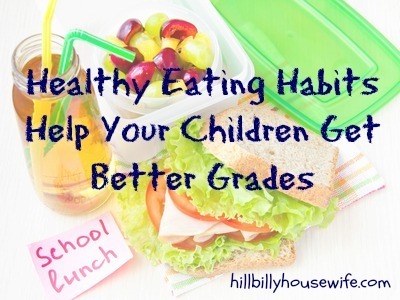Healthy Eating Habits Will Help Your Children Get Better Grades
We all want our children to be healthy, happy and well-nourished. Studies show that kids who eat healthy do better academically in school. At the opposite end of the spectrum, kids who are malnourished tend to struggle with school in every way, from missing classes to having to take classes or even whole grade levels over again. Doesn’t it seem wise to give your children the best chance to be healthy in order to succeed in school?
It’s not just that your children eat; it’s what your children eat. Your children’s nutritional needs should be something you think about on a consistent basis. Let’s take a look at a few issues that should be addressed in order to get your kids performing and learning at their peak.
What’s for Breakfast?
Mornings are usually the most hectic time. Kids are buzzing around getting ready for school and are in a hurry to get out the door. They may just grab a donut or toaster treat on the way past the kitchen or maybe sitting down long enough to gulp down a bowl of cereal. Have you ever stopped to think what’s in all that processed quick food your filling your child’s belly with? Most cereals and other fast breakfast foods are loaded with sugar, preservatives and empty calories.
One the easiest thing you can do for your children is to make sure they have a well-balanced breakfast before they head off to school. You can do this without having to go to a whole lot of trouble or slaving over the stove. A good start to the day, nutritionally speaking, can include eggs, smoothies, fruits, nuts and veggies. Just remember in the morning it’s got to be easy and fast.
It’s been proven time and time again that schools that provide breakfast for students tend to have a higher number of kids excel in their curriculum. This is a testament to the power of eating a healthy breakfast. Giving your children a quick, nutritious breakfast is as important to their academic success as helping them with their homework. So, even if your kids have to grab their breakfast and run, make whatever they are grabbing a nutritional powerhouse.
Cafeteria or Homemade Lunch?
If you send you kids off with money for cafeteria lunch, have you checked out the nutritional value? Many schools do not provide what you would call well-balanced selections.
Another thing is if you just hand your child lunch money, are you sure your child will use it to buy healthy foods? That lunch money may be going toward sugar and fat saturated fast food or vending machine treats in the school. The school may have healthier options in the vending machine, but is your child making that choice?
The smartest choice may be to pack a healthy homemade lunch for your child. I know you’re thinking who’s got time to pack a lunch every day? An easy way to get this done without adding another thing to your morning routine is to make their lunches at night and have them ready to go in the fridge. Remember, your child’s health and grades are at stake!
So, let’s make it easy as well as nutritious, shall we? Planning is the key. Your child needs several basics for a well-balanced diet. Include a vegetable, fruit, protein, grain and calcium of some sort in the lunch bag. It can be a tuna sandwich on whole grain bread with a slice of cheese and lettuce with a side of grapes or a turkey wrap with spinach and a cup of fruit yogurt with granola. Even peanut butter on whole wheat bread with an apple is healthier than a bag of chips in the vending machine. Keep it simple and be creative and you’ll find ways to provide a healthy lunch.
All About Snacks
A late afternoon snack is a must to keep kids energy from waning. Some schools provide snacks for their students. Unfortunately, many kids eat processed foods loaded with fat and sugar to tide them over until dinner.
To steer your kids away from the vending machine have a small pack of snacks ready for them to grab when their stomach starts to grumble. A handful of nuts, some dried fruit, trail mix, or even a few whole grain crackers may be just enough to give your child an energy boost in a healthier way. If you buy snack bars, make sure you read the labels to ensure they are actually healthy. Some are labeled as ‘protein bars’ but they are packed with loads of sugar and other unhealthy ingredients.
A Little Planning Pays Off
It’s easier than you may think to make or buy healthy foods for your children to take to school. First off make a list of all the healthy snacks your children like. This may be a small list at first if they are not used to eating healthy foods. You can start with what they like and begin by having them expand their palate by trying new items at home. If they like it then you can add it to the list.
Then you will want to go to the grocery store with your children to pick out food for their school days. You will have to steer your child them away from processed junk and candy at first and a simple, yet firm, reminder that none of that is going in their backpack may be in order. It’s time to make healthier choices and your child needs your guidance.
Get your child involved in preparing the meals and snacks. Lay out the food and tell your child that there are basic nutritional elements that belong in each meal. Group those elements together and tell your child that they can mix and match them in any way they want just as long as they have balanced out each meal.
You can take this planning as far as you want and be as organized as you like. Or just throw all the food together and prepare the meals each day as you go. The main thing is you have given your children healthy foods to build their school day around.
If you want your child to do well academically, you need to start from the inside out. Choose a well-balanced breakfast, a healthy lunch, and snacks that satisfy without all the processed sugar and other junk. Give your children all the nutrition they need to feed their bodies and brains for a successful school year while building lifelong habits.

To support the blog, check out the HBHW eBooks available on Amazon. Thank you!
Disclosure: Some of the links below are affilate links, meaning, at no additional cost to you, I will earn a commission if you click through and make a purchase.

